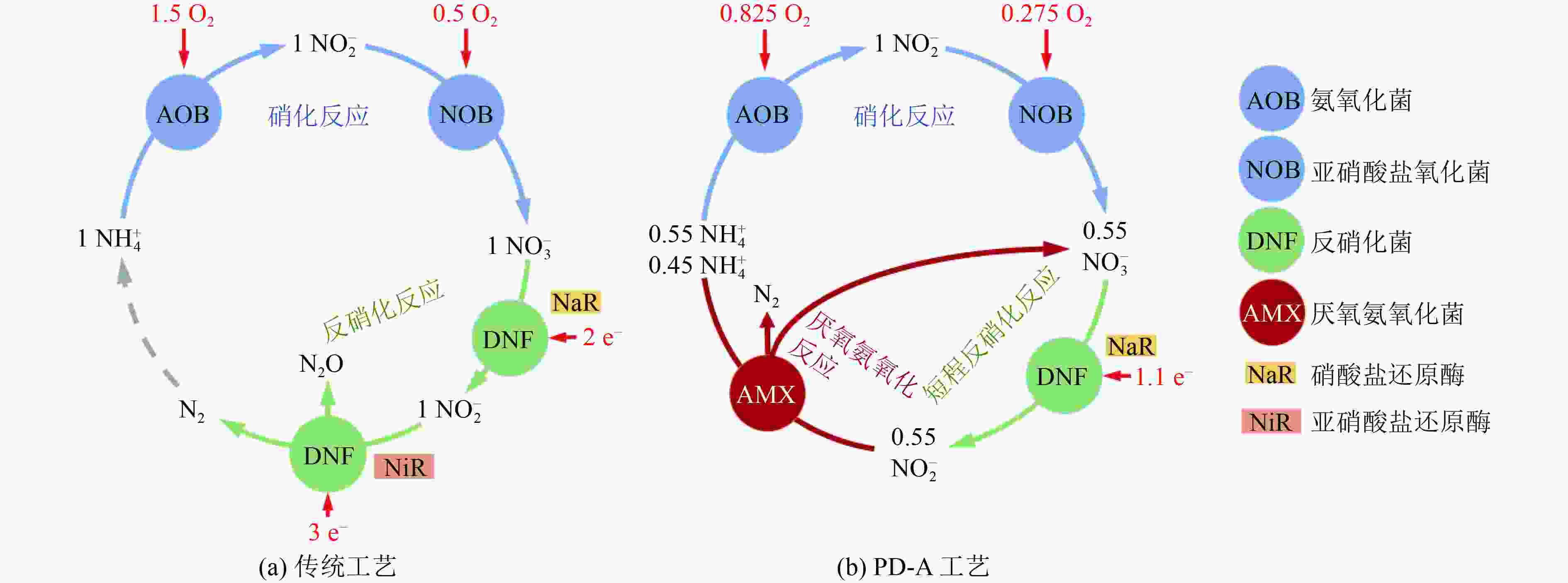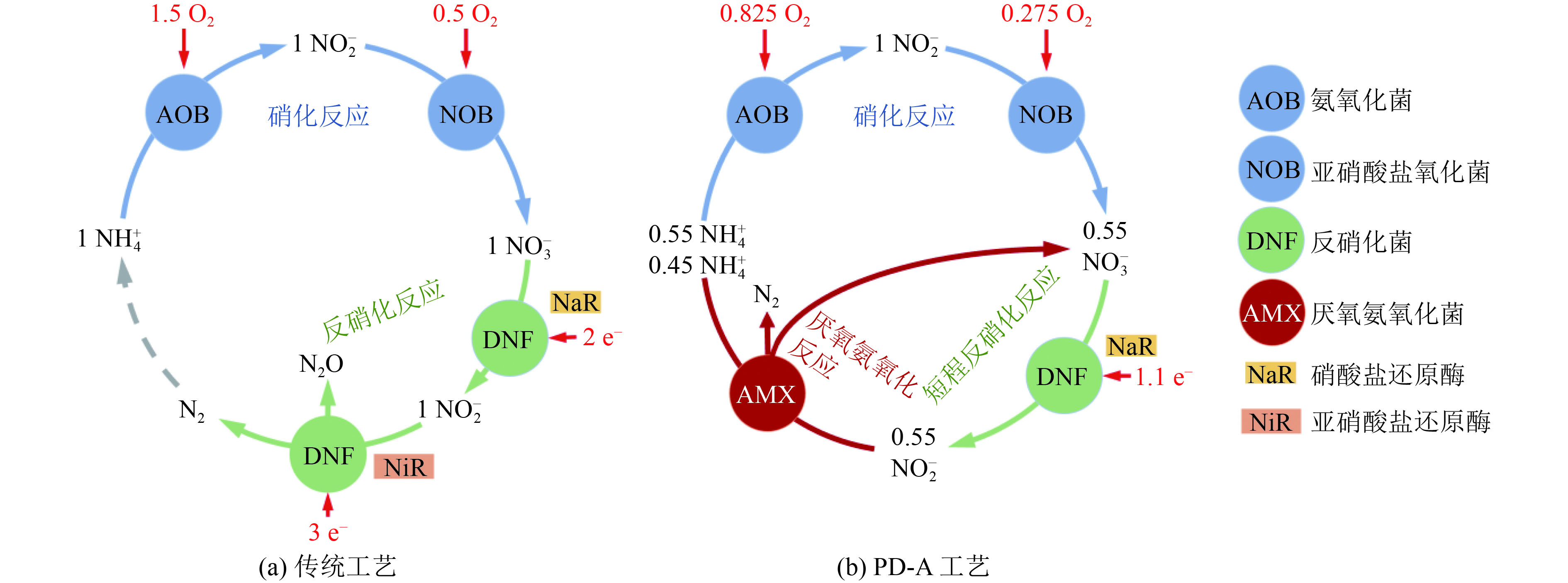Research and application progress of partial denitrification coupled with anammox for enhanced denitrification
-
摘要:
短程反硝化耦合厌氧氨氧化(PD-A)工艺外加碳源和曝气成本较低、NO2 −生成稳定高效、总氮去除率高,并且可以减少温室气体N2O的排放,是一种新型的生物脱氮工艺。现有关于PD-A的研究多以水质条件单一的模拟废水为对象,针对实际废水的研究尚少。分析了PD-A工艺的机制与特点,通过对比核心功能菌短程反硝化菌和厌氧氨氧化菌的最佳生长条件,并结合现有研究提出PD-A工艺运行的优化策略,继而分析了PD-A工艺在实际废水中的应用案例。结果表明,优化COD/NO3 −、接种不同结构的污泥和添加生物膜载体等有利于工艺高效稳定地运行;PD-A工艺在实际生活污水、养殖废水、高硝酸盐废水的处理中实现了较高的脱氮率,说明其处理实际废水具有可行性。最后,对PD-A工艺的发展进行展望,认为应以实际废水为处理对象,进一步研究系统内核心菌群的协同作用机制和混合生物脱氮调控方式,以提升工艺的稳定性及碳氮协同处理效率。
-
关键词:
- 短程反硝化耦合厌氧氨氧化(PD-A) /
- 脱氮 /
- 运行策略 /
- 实际废水
Abstract:As a novel biological nitrogen removal process, partial denitrification coupled with anammox (PD-A) process can save the cost of aeration and external carbon source, generate NO2 − steadily and efficiently and have high removal efficiency of total nitrogen. Besides, PD-A process can reduce the emission of greenhouse gas N2O. Existing researches on PD-A mostly focus on the simulated wastewater with single water quality conditions while the research on the real wastewater is still missing. The mechanism and characteristics of PD-A process were analyzed, the optimization strategy of PD-A process operation was proposed through comparing the optimal growth conditions of core functional bacteria, partial denitrification bacteria and anammox bacteria, in combination with the existing researches. Then the application cases of PD-A process in the real wastewater were analyzed. The results showed that optimizing COD/NO3 −, inoculating sludge with different structures and adding biofilm carriers were beneficial to the efficient and stable operation of the process. PD-A process could achieve higher nitrogen removal efficiency in the treatment of real domestic sewage, aquaculture wastewater and high nitrate wastewater, indicating that the treatment of real wastewater through PD-A process was feasible. Finally, the development trend of PD-A process was forecasted, the real wastewater should be treated, and the synergy mechanism of the core flora in the system and the mixed biological denitrification control method should be further studied to improve the stability of the process and the efficiency of synergistic removal of carbon and nitrogen.
-
表 1 反硝化过程酶的类型、表达条件及编码基因
Table 1. Type, expression conditions and coding genes of denitrifying enzymes
酶 类型 表达条件 编码基因 NaR 周质硝酸还原酶(好氧菌) 在有氧和无氧条件下均能表达,
且在有氧条件下优先表达napA 膜结合硝酸还原酶(厌氧菌) 在厌氧条件下优先表达 narG、narH、narI NiR 血红素亚硝酸盐还原酶 有氧或无氧 nirS 铜型亚硝酸盐还原酶 有氧或无氧 nirK NoR NO还原酶 在高氧和低pH下优先表达 norCB Nos N2O还原酶 低氧或缺氧,易受pH、氧的抑制 nosZ 表 2 短程反硝化菌与厌氧氨氧化菌最佳生长条件
Table 2. The best growth conditions for partial denitrification bacteria and anammox bacteria
表 3 PD-A工艺运行参数及运行状况
Table 3. Operating parameters and operating conditions of PD-A process
-
[1] 中华人民共和国国民经济和社会发展第十四个五年规划和2035年远景目标纲要[R]. 北京: 国务院, 2021. [2] RAVISHANKARA A R, DA NIEL J S, PORTMANN R W. Nitrous oxide (N2O): the dominant ozone-depleting substance emitted in the 21st century[J]. Science,2009,326(5949):123-125. doi: 10.1126/science.1176985 [3] 郭盛杰, 黄海伟, 董欣, 等.中国城镇污水处理行业温室气体排放核算及其时空特征分析[J]. 给水排水,2019,45(4):56-62. doi: 10.13789/j.cnki.wwe1964.2019.04.009GUO S J, HUANG H W, DONG X, et al. Calculation of greenhouse gas emissions of municipal wastewater treatment and its temporal and spatial trend in China[J]. Water & Wastewater Engineering,2019,45(4):56-62. doi: 10.13789/j.cnki.wwe1964.2019.04.009 [4] GUO Y, LUO Z B, SHEN J H, et al. The main anammox-based processes, the involved microbes and the novel process concept from the application perspective[J]. Frontiers of Environmental Science & Engineering,2022,16(7):84. [5] KARTAL B, KUENEN J G, LOOSDRECHT M V. Engineering sewage treatment with anammox[J]. Science,2010,328(5979):702-703. [6] STROUS M, HEIJNEN J J, KUENEN J G, et al. The sequencing batch reactor as a powerful tool for the study of slowly growing anaerobic ammonium-oxidizing microorganisms[J]. Applied Microbiology and Biotechnology,1998,50(5):589-596. doi: 10.1007/s002530051340 [7] ZHAO Y, ZHANG Q, PENG Y, et al. Advanced nitrogen elimination from domestic sewage through two stage partial nitrification and denitrification (PND) coupled with simultaneous anaerobic ammonia oxidation and denitrification (SAD)[J]. Bioresource Technology,2022,343:125986. doi: 10.1016/j.biortech.2021.125986 [8] ZHANG M, WANG S, JI B, et al. Towards mainstream deammonification of municipal wastewater: partial nitrification-anammox versus partial denitrification-anammox[J]. Science of the Total Environment,2019,692:393-401. doi: 10.1016/j.scitotenv.2019.07.293 [9] MA W J, LI G F, HUANG B C, et al. Advances and challenges of mainstream nitrogen removal from municipal wastewater with anammox-based processes[J]. Water Environment Research,2020,92(11):1899-1909. [10] 徐浩, 田智勇, 宋永会, 等.ANAMMOX生物滤池深度处理干法腈纶废水的性能与可行性[J]. 环境工程技术学报,2013,3(4):286-292. doi: 10.3969/j.issn.1674-991X.2013.04.045XU H, TIAN Z Y, SONG Y H, et al. Performance and feasibility of ANAMMOX bio-filter process for advanced treatment of dry-spun acrylic fiber wastewater[J]. Journal of Environmental Engineering Technology,2013,3(4):286-292. doi: 10.3969/j.issn.1674-991X.2013.04.045 [11] 王茜, 陈琴, 曾涛涛, 等.基于短程硝化工艺的垃圾渗滤液脱氮处理研究进展[J]. 环境工程技术学报,2016,6(2):127-132. doi: 10.3969/j.issn.1674-991X.2016.02.019WANG Q, CHEN Q, ZENG T T, et al. Review of nitrogen removal for landfill leachate based on partial nitrification technology[J]. Journal of Environmental Engineering Technology,2016,6(2):127-132. doi: 10.3969/j.issn.1674-991X.2016.02.019 [12] LACKNER S, GILBERT E M, VLAEMINCK S E, et al. Full-scale partial nitritation/anammox experiences: an application survey[J]. Water Research,2014,55:292-303. doi: 10.1016/j.watres.2014.02.032 [13] DU R, CAO S, LI B, et al. Performance and microbial community analysis of a novel DEAMOX based on partial-denitrification and anammox treating ammonia and nitrate wastewaters[J]. Water Research,2016,108:46-56. [14] PAN Y, NI B J, BOND P L, et al. Electron competition among nitrogen oxides reduction during methanol-utilizing denitrification in wastewater treatment[J]. Water Research,2013,47(10):3273-3281. [15] LI W, ZHENG P, GUO J, et al. Characteristics of self-alkalization in high-rate denitrifying automatic circulation (DAC) reactor fed with methanol and sodium acetate[J]. Bioresource Technology,2014,154:44-50. doi: 10.1016/j.biortech.2013.11.097 [16] JI J, PENG Y, BO W, et al. Achievement of high nitrite accumulation via endogenous partial denitrification (EPD)[J]. Bioresource Technology,2017,224:140-146. doi: 10.1016/j.biortech.2016.11.070 [17] DU R, CAO S, NIU M, et al. Performance of partial-denitrification process providing nitrite for anammox in sequencing batch reactor (SBR) and upflow sludge blanket (USB) reactor[J]. International Biodeterioration & Biodegradation,2017,122:38-46. [18] 卢文显, 李敏.反硝化细菌在废水治理中的应用: 原理与现状[J]. 福建师范大学学报(自然科学版),2015,31(3):111-117.LU W X, LI M. The potential application of denitrifying bacteria in the treatment of wastewater: theory and advances[J]. Journal of Fujian Normal University (Natural Science Edition),2015,31(3):111-117. [19] ZUMFT W G. Cell biology and molecular basis of denitrification[J]. Microbiology and Molecular Biology Reviews,1997,61(4):533-616. [20] ZHANG Z, ZHANG Y, CHEN Y. Recent advances in partial denitrification in biological nitrogen removal: from enrichment to application[J]. Bioresource Technology,2019,298:122444. [21] QIAN W, MA B, LI X, et al. Long-term effect of pH on denitrification: high pH benefits achieving partial-denitrification[J]. Bioresource Technology,2019,278:444-449. [22] 肖晶晶, 郭萍, 霍炜洁, 等.反硝化微生物在污水脱氮中的研究及应用进展[J]. 环境科学与技术,2009,32(12):97-102. doi: 10.3969/j.issn.1003-6504.2009.12.022XIAO J J, GUO P, HUO W J, et al. Application of denitrifying microbes to wastewater denitrification[J]. Environmental Science & Technology,2009,32(12):97-102. doi: 10.3969/j.issn.1003-6504.2009.12.022 [23] 袁怡, 黄勇, 邓慧萍, 等.C/N比对反硝化过程中亚硝酸盐积累的影响分析[J]. 环境科学,2013,34(4):1416-1420. doi: 10.13227/j.hjkx.2013.04.056YUAN Y, HUANG Y, DENG H P, et al. Effect of C/N ratio on nitrite accumulation during denitrification process[J]. Environmental Science,2013,34(4):1416-1420. doi: 10.13227/j.hjkx.2013.04.056 [24] KRISHNA MOHAN T V, NANCHARAIAH Y V, VENUGOPALAN V P, et al. Effect of C/N ratio on denitrification of high-strength nitrate wastewater in anoxic granular sludge sequencing batch reactors[J]. Ecological Engineering,2016,91:441-448. [25] GE S, PENG Y, WANG S, et al. Nitrite accumulation under constant temperature in anoxic denitrification process: the effects of carbon sources and COD/NO3-N[J]. Bioresource Technology,2012,114:137-143. doi: 10.1016/j.biortech.2012.03.016 [26] KARTAL B, VAN NIFTRIK L, RATTRAY J, et al. Candidatus 'Brocadia fulgida': an autofluorescent anaerobic ammonium oxidizing bacterium[J]. FEMS Microbiology Ecology,2008,63(1):46-55. [27] DALSGAARD T, CANFIELD D E, PETERSEN J, et al. N2 production by the anammox reaction in the anoxic water column of Golfo Dulce, Costa Rica[J]. Nature,2003,422(6932):606-608. [28] ZHU G, WANG S, WANG W, et al. Hotspots of anaerobic ammonium oxidation at land-freshwater interfaces[J]. Nature Geoscience,2013,6(2):103-107. doi: 10.1038/ngeo1683 [29] 李权, 王少坡, 李博洋, 等.厌氧氨氧化菌种类及其与各类功能菌在ANAMMOX系统内的协作[J]. 水处理技术,2018,44(7):10-16. doi: 10.16796/j.cnki.1000-3770.2018.07.003LI Q, WANG S P, LI B Y, et al. Species of anaerobic ammonium oxidizing bacteria and cooperative regulation of the functional bacterium in ANAMMOX processes[J]. Technology of Water Treatment,2018,44(7):10-16. doi: 10.16796/j.cnki.1000-3770.2018.07.003 [30] WANG Q, WANG Y, LIN J, et al. Selection of seeding strategy for fast start-up of anammox process with low concentration of anammox sludge inoculum[J]. Bioresource Technology,2018,268:638-647. [31] FU L, CHEN Y, LI S, et al. Shifts in the anammox bacterial community structure and abundance in sediments from the Changjiang Estuary and its adjacent area[J]. Systematic and Applied Microbiology,2019,42(3):383-396. [32] JENNI S, VLAEMINCK S E, MORGENROTH E, et al. Successful application of nitritation/anammox to wastewater with elevated organic carbon to ammonia ratios[J]. Water Research,2014,49(2):316-326. [33] HE S, ZHANG Y, NIU Q, et al. Operation stability and recovery performance in an anammox EGSB reactor after pH shock[J]. Ecological Engineering,2016,90:50-56. doi: 10.1016/j.ecoleng.2016.01.084 [34] YUE X, YU G, LU Y, et al. Effect of dissolved oxygen on nitrogen removal and the microbial community of the completely autotrophic nitrogen removal over nitrite process in a submerged aerated biological filter[J]. Bioresource Technology,2018,254:67-74. [35] LIU T, QUAN X, LI D. Evaluations of biofilm thickness and dissolved oxygen on single stage anammox process in an up-flow biological aerated filter[J]. Biochemical Engineering Journal,2017,119:20-26. doi: 10.1016/j.bej.2016.12.006 [36] KIMURA Y, ISAKA K, KAZAMA F. Tolerance level of dissolved oxygen to feed into anaerobic ammonium oxidation (anammox) reactor[J]. Journal of Water and Environment Technology,2011,9(2):169-178. doi: 10.2965/jwet.2011.169 [37] MOLINUEVO B, GARCIA M, KARAKASHEV D, et al. Anammox for ammonia removal from pig manure effluents: effect of organic matter content on process performance[J]. Bioresource Technology,2009,99(7):2171-2175. [38] JIN R C, YANG G F, YU J J, et al. The inhibition of the anammox process: a review[J]. Chemical Engineering Journal,2012,197:67-79. doi: 10.1016/j.cej.2012.05.014 [39] HE S, NIU Q, MA H, et al. The treatment performance and the bacteria preservation of anammox: a review[J]. Water, Air, & Soil Pollution,2015,226(5):1-16. [40] JEILL O H, SILVERSTEIN J. Oxygen inhibition of activated sludge denitrification[J]. Water Research,1999,33(8):1925-1937. doi: 10.1016/S0043-1354(98)00365-0 [41] KUMAR M, LIN J G. Co-existence of anammox and denitrification for simultaneous nitrogen and carbon removal-strategies and issues[J]. Journal of Hazardous Materials,2010,178(1/2/3):1-9. [42] DU R, CAO S, LI B, et al. Simultaneous domestic wastewater and nitrate sewage treatment by denitrifying ammonium oxidation (DEAMOX) in sequencing batch reactor[J]. Chemosphere,2017,174:399-407. doi: 10.1016/j.chemosphere.2017.02.013 [43] LI J, PENG Y, ZHANG L, et al. Quantify the contribution of anammox for enhanced nitrogen removal through metagenomic analysis and mass balance in an anoxic moving bed biofilm reactor[J]. Water Research,2019,160:178-187. doi: 10.1016/j.watres.2019.05.070 [44] DU R, PENG Y, CAO S, et al. Mechanisms and microbial structure of partial denitrification with high nitrite accumulation[J]. Applied Microbiology & Biotechnology,2016,100(4):2011-2021. [45] CAO S, DU R, NIU M, et al. Integrated anaerobic ammonium oxidization with partial denitrification process for advanced nitrogen removal from high-strength wastewater[J]. Bioresource Technology,2016,221:37-46. doi: 10.1016/j.biortech.2016.08.082 [46] SHI L, DU R, PENG Y. Achieving partial denitrification using carbon sources in domestic wastewater with waste-activated sludge as inoculum[J]. Bioresource Technology,2019,283:18-27. doi: 10.1016/j.biortech.2019.03.063 [47] JI J, PENG Y, MAI W, et al. Achieving advanced nitrogen removal from low C/N wastewater by combining endogenous partial denitrification with anammox in mainstream treatment[J]. Bioresource Technology,2018,270:570-579. doi: 10.1016/j.biortech.2018.08.124 [48] LI J, LI J, GAO R, et al. A critical review of one-stage anammox processes for treating industrial wastewater: optimization strategies based on key functional microorganisms[J]. Bioresource Technology,2018,265:498-505. doi: 10.1016/j.biortech.2018.07.013 [49] MA B, QIAN W, YUAN C, et al. Achieving mainstream nitrogen removal through coupling anammox with denitratation[J]. Environmental Science & Technology,2017,51(15):8405-8413. [50] CAO S, PENG Y, DU R, et al. Feasibility of enhancing the denitrifying ammonium oxidation (DEAMOX) process for nitrogen removal by seeding partial denitrification sludge[J]. Chemosphere,2016,148:403-407. doi: 10.1016/j.chemosphere.2015.09.062 [51] VEUILLET F, LACROIX S, BAUSSERON A, et al. Integrated fixed-film activated sludge ANITA (TM) Mox process: a new perspective for advanced nitrogen removal[J]. Water Science & Technology,2014,69(5):915-922. [52] 杨岚, 彭永臻, 李健伟, 等.缺氧MBBR耦合部分厌氧氨氧化强化城市生活污水深度脱氮[J]. 环境科学,2019,40(8):3668-3674. doi: 10.13227/j.hjkx.201901015YANG L, PENG Y Z, LI J W, et al. Advanced denitrification of municipal wastewater achieved via partial ANAMMOX in anoxic MBBR[J]. Environmental Science,2019,40(8):3668-3674. doi: 10.13227/j.hjkx.201901015 [53] CHEN H, HU H Y, CHEN Q Q, et al. Successful start-up of the anammox process: influence of the seeding strategy on performance and granule properties[J]. Bioresource Technology,2016,211:594-602. doi: 10.1016/j.biortech.2016.03.139 [54] 张泽文, 李冬, 张杰, 等.接种单一/混合污泥对厌氧氨氧化反应器快速启动的影响[J]. 环境科学,2017,38(12):5215-5221. doi: 10.13227/j.hjkx.201705289ZHANG Z W, LI D, ZHANG J, et al. Effect of seeding single /mixed sludge on rapid start-up of an ANAMMOX reactor[J]. Environmental Science,2017,38(12):5215-5221. doi: 10.13227/j.hjkx.201705289 [55] ZHANG H, DU R, CAO S, et al. Mechanisms and characteristics of biofilm formation via novel DEAMOX system based on sequencing biofilm batch reactor[J]. Journal of Bioscience & Bioengineering,2018,127(2):206-212. [56] DU R, PENG Y, CAO S, et al. Advanced nitrogen removal from wastewater by combining anammox with partial denitrification[J]. Bioresource Technology,2015,179:497-504. doi: 10.1016/j.biortech.2014.12.043 [57] 程军, 张亮, 杨延栋, 等.一体化厌氧氨氧化反应器的优化及其稳定性研究[J]. 中国环境科学,2016,36(4):1027-1032. doi: 10.3969/j.issn.1000-6923.2016.04.010CHENG J, ZHANG L, YANG Y D, et al. Optimization and stability of single-stage anammox reactor[J]. China Environmental Science,2016,36(4):1027-1032. doi: 10.3969/j.issn.1000-6923.2016.04.010 [58] 刘国华, 李钦渝, 徐相龙, 等.IFAS污水处理工艺的研究进展[J]. 环境工程,2022,40(2):214-224. doi: 10.13205/j.hjgc.202202032LIU G H, LI Q Y, XU X L, et al. Research progress of IFAS process for wastewater treatment[J]. Environmental Engineering,2022,40(2):214-224. doi: 10.13205/j.hjgc.202202032 [59] DENG L J, GUO W S, NGO H H, et al. New functional biocarriers for enhancing the performance of a hybrid moving bed biofilm reactor–membrane bioreactor system[J]. Bioresource Technology,2016,208:87-93. doi: 10.1016/j.biortech.2016.02.057 [60] REGMI P, HOLGATE B, MILLER M W, et al. Nitrogen polishing in a fully anoxic anammox MBBR treating mainstream nitritation-denitritation effluent[J]. Biotechnology and Bioengineering,2016,113(3):635-642. doi: 10.1002/bit.25826 [61] HENDRICKX T L, WANG Y, KAMPMAN C, et al. Autotrophic nitrogen removal from low strength waste water at low temperature[J]. Water Research,2012,46(7):2187-2193. doi: 10.1016/j.watres.2012.01.037 [62] LU G, MA Y, ZANG L, et al. Effects of granular activated carbon and Fe-modified granular activated carbon on anammox process start-up[J]. RSC Advances,2021,11(18):10625-10634. doi: 10.1039/D1RA00384D [63] CHEN Y, ZHAO Z, LIU H, et al. Achieving stable two-stage mainstream partial-nitrification/anammox (PN/A) operation via intermittent aeration[J]. Chemosphere,2020,245:125650. doi: 10.1016/j.chemosphere.2019.125650 [64] ZHENG B, ZHANG L, GUO J, et al. Suspended sludge and biofilm shaped different anammox communities in two pilot-scale one-stage anammox reactors[J]. Bioresource Technology,2016,211:273-279. doi: 10.1016/j.biortech.2016.03.049 [65] SCAGLIONE D, FICARA E, CORBELLINI V, et al. Autotrophic nitrogen removal by a two-step SBR process applied to mixed agro-digestate[J]. Bioresource Technology,2015,176:98-105. doi: 10.1016/j.biortech.2014.11.019 [66] WANG Y, XIE H, WANG D, et al. Insight into the response of anammox granule rheological intensity and size evolution to decreasing temperature and influent substrate concentration[J]. Water Research,2019,162:258-268. doi: 10.1016/j.watres.2019.06.060 [67] LUYARA D, PEREIRA A D, LEAL C D, et al. Effect of temperature on microbial diversity and nitrogen removal performance of an anammox reactor treating anaerobically pretreated municipal wastewater[J]. Bioresource Technology,2018,258:208-219. doi: 10.1016/j.biortech.2018.02.083 [68] ISHIMOTO C, SUGIYAMA T, MATSUMOTO T, et al. Full-scale simultaneous partial nitrification, anammox, and denitrification process for treating swine-wastewater[J]. Water Science & Technology,2020,81(3):456-465. [69] CAO S, DU R, LI B, et al. Nitrite production from partial-denitrification process fed with low carbon/nitrogen (C/N) domestic wastewater: performance, kinetics and microbial community[J]. Chemical Engineering Journal,2017,326:1186-1196. doi: 10.1016/j.cej.2017.06.066 [70] COLDEBELLA, ARLEI, BORTOLI, et al. Kinetic models for nitrogen inhibition in ANAMMOX and nitrification process on deammonification system at room temperature[J]. Bioresource Technology,2016,202:33-41. doi: 10.1016/j.biortech.2015.11.048 [71] LAURENI M, FALAS P, ROBIN O, et al. Mainstream partial nitritation and anammox: long-term process stability and effluent quality at low temperatures[J]. Water Research,2016,101:628-639. doi: 10.1016/j.watres.2016.05.005 [72] HE S, CHEN Y, QIN M, et al. Effects of temperature on anammox performance and community structure[J]. Bioresource Technology,2018,260:186-195. ⊗ doi: 10.1016/j.biortech.2018.03.090 -





 下载:
下载:




